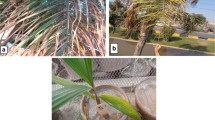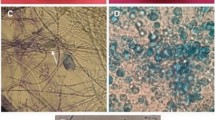Abstract
Fusarium oxysporum, an important soil-borne fungal pathogen, is a species complex consisting of multiple cryptic species. Many special forms (f.sp.) are known in F. oxysporum, on the basis of the pathogenicity of each particular fungal isolate against particular host plants. F. oxysporum f.sp. cubense (Foc) is known as the causative agent of Panama disease on banana. In the present research, fungal isolates were obtained from the pseudostems of Musa acuminata var. Dwarf Cavendish in the south of Sistan & Baluchestan Province in early 2022. A combination of two-locus sequence analysis of the concatenated rpb2 (DNA-directed RNA polymerase II largest subunit) and tef1 (translation elongation factor 1-α) partial sequences showed that the isolates belong to the Fusarium cugenangense (F. oxysporum species complex (FOSC) Clade 2).
In order to use eco-friendly method for controlling fungi, the antifungal effect of some essential oils (EO) were evaluated based on mycelia growth, sporulation and spore germination and compared with a Iprodione+Carbendazim (Rovral-TS ®) fungicide. Of these, the antifungal effect of Satureja hortensis EO was higher than those from other plants examined in this research. GC/MS analysis was performed to identify the main components of S. hortensis EO. α-pinene and Myrcene were the most important components with antifungal effects. The inhibitory concentration 50 and minimum inhibitory concentration of S. hortensis EO were 95 ppm and 174.75 ppm respectively, revealing that the essential oil gave better results at low concentration than the fungicide. Furthermore, a combination of α-pinene with Myrcene resulted in a synergistic effect on the fungus. Other components showed additive effects.








Similar content being viewed by others
References
Achari, S. R., Kaur, J., Dinh, Q., Mann, R., Sawbridge, T., Summerell, B. A., & Edwards, J. (2020). Phylogenetic relationship between Australian fusarium oxysporum isolates and resolving the species complex using the multispecies coalescent model. BMC Genomics, 21, 248.
Adams, R. P. (2001). Identification of essential oil components by gas chromatography mass spectroscopy (p. 456). Illinois Allured Publication Corporation.
Aguayo, J., Mostert, D., Fourrier-Jeandel, C., et al. (2017). Development of a hydrolysis probe-based real-time assay for the detection of tropical strains of fusarium oxysporum f. sp. cubense race 4. Plos One, 12(2), e0171767. https://doi.org/10.1371/journal.pone.0171767
Anonymous. (1987). POLO-PC. A user’s guide to probit or logit analysis.
Atrash, S., Ramezanian, A., Rahemi, M., Mostofizadeh, R., & Yahia, E. (2018). Antifungal effects of savory essential oil, gum arabic and hot water in mexican lime fruits. American Society for Horticultural Science, 53(4), 524–530.
Bozhuyuk, A. U., Komaki, A., Kordali, S., & Ustuner, T. (2019). Assessment of the growth inhibiting effect of Satureja essential oil on different fusarium species from wheat. Fresenius Environmental Bulletin, 28(11), 8199–8206.
Correll, J. C. (1991). The relationship between formae speciales, races, and vegetative compatibility groups in fusarium oxysporum. Phytopathology, 81, 1061–1064.
Costa, L. C. B., Pinto, J. E. B. P., Bertolucci, S. K. V., Costa, J. C. D. B., Alves, P. B., & Niculau, E. D. S. (2015). In vitro antifungal activity of Ocimum selloi essential oil and methylchavicol against phytopathogenic fungi. Revista Ciência Agronômica, 46, 428–435.
Damodaran, T., Mishra, V.K., Jha, S.K., Gopal, R., Rajan, S., & Ahmed, I. (2019). First report of fusarium wilt in Banana caused by fusarium oxysporum f.sp. cubense race 4 in India. APS publications, https://doi.org/10.1094/PDIS-07-18-1263-PDN
García–Bastidas, F., Ordóñez, N., Konkol, J., Al-Qasim, M., Naser, Z., Abdewali, M., et al. (2014). First report of fusarium oxysporum f. sp cubense tropical race 4 associated with Panama disease of banana outside Southeast Asia. Plant Diseases, 98, 694.
Gerlach, W., & Ershad, D. (1970). Beitrag zur Kenntnis der Fusarium und Cylindrocarpon Arten in Iran. Nova Hedwigia, 20, 725–784.
Hyldgaard, M., Mygind, T., & Meyer, R. L. (2012). Essential oils in food preservation: Mode of action, synergies and interactions with food matrix components. Microbiology. https://doi.org/10.3389/fmicb.2012.00012
Kryzsko-Lupicka, T., Walkowiak, W., & Bialon, M. (2019). Comparison of the fungistatic activity of selected essential oils relative to F. graminearum isolates. Molecules, 24, 311.
Lahooji, A., Mirabolfathy, M., & Karami-Osboo, R. (2010). Effect of Zataria multiflora and Satureja hortensis essential oils thymol and Carvacrol on growth of fusarium gramineum isolates and deoxynivalenol production. Iranian Journal of Plant Pathology, 46(1), 11–13.
Leber, A. L. (2016). Clinical microbiology procedures handbook, ASM Press, 4th edn, vol. 1–3.
Leslie, J. F. & Summerell, B. A. (2006) The fusarium laboratory manual (pp. 1–2). Blackwell Publishing, Hoboken. https://doi.org/10.1002/9780470278376
Lombard, L., Sandoval-Denis, M., Lamprecht, S. C., & Crous, P. W. (2019). Epitypification of fusarium oxysporum– Clearing the taxonomic chaos. Persoonia, 43, 1–47.
Maryani, N., Lombard, L., Poerba, Y. S., Subandiyah, S., Crous, P. W., & Kema, G. H. J. (2019). Phylogeny and genetic diversity of the banana fusarium wilt pathogen fusarium oxysporum f. sp. cubense in the Indonesian Centre of origin. Studies in Mycology, 92, 155–194.
Mihajilov-Kretev, T., Radnovic, D., Kitic, D., Stojanovic-Radic, Z., & Bojan, Z. (2010). Antimicrobial activity of Satureja hortensis L. essential oil against pathogenic microbial strains. Arch. Biological Sciences, 62(1), 159–166.
Mohammadi, Z., & Atik, F. (2013). Fungitoxic effect of natural extracts on mycelial growth, spore germination and aflatoxin B1 production of aspergillus flavus. Australian Journal of Crop Science, 7(3), 293–298.
Moore, N. Y., Pegg, K. G., Allen, R. N., et al. (1993). Vegetative compatibility and distribution of fusarium oxysporum f.sp. cubense in Australia. Animal Production Science, 33, 797–802.
Nguefack, J., Tamgue, O., Dongmo, J. B. L., Dakole, C. D., Leth, V., Vismer, H. F., Zollo, P. H. A., & Nkengfack, A. E. (2012). Synergistic action between fractions of essential oils from Cymbopogon citratus, Ocimum gratissimum and Thymus vulgaris against Penicillium expansum. Food Control, 23, 377–383.
O’Donnell, K., Gueidan, C., Sink, S., Johnston, P. R., Crous, P. W., Glenn, A., Riley, R., Zitomer, N. C., Colyer, P., Waalwijk, C., et al. (2009). A two-locus DNA sequence database for typing plant and human pathogens within the fusarium oxysporumspecies complex. Fungal Genetics and Biology, 46, 936–948.
O’Donnell, K., Kistler, H. C., Cigelnik, E., & Ploetz, R. C. (1998). Multiple evolutionary origins of the fungus causing Panama disease of banana: Concordant evidence from nuclear and mitochondrial gene genealogies. Proceedings of the National Academy of Sciences of the United States of America, 95, 2044–2049.
O’Donnell, K., Sutton, D. A., Fothergill, A., McCarthy, D., Rinaldi, M. G., Brandt, M. E., Zhang, N., & Geiser, D. M. (2008). Molecular phylogenetic diversity, multilocus haplotype nomenclature, and in vitro antifungal resistance within the fusarium solani species complex. Journal of Clinical Microbiology, 46, 2477–2490.
O’Donnell, K., Sutton, D. A., Rinaldi, M. G., Sarver, B. A., Balajee, S. A., Schroers, H. J., Summerbell, R. C., Robert, V. A. R. G., Crous, P. W., Zhang, N., Aoki, T., Jung, K., Park, J., Lee, Y. H., Kang, S., Park, B., & Geiser, D. M. (2010). Internet-accessible DNA sequence database for identifying fusaria from human and animal infections. Journal of Clinical Microbiology, 48, 3708–3371.
O’Donnell, K., Ward, T. J., Robert, V. A. R. G., et al. (2015). DNA sequence-based identification of fusarium: Current status and future directions. Phytoparasitica, 43, 583–595.
Rguez, S., Hamrouni Sellami, I., Abid, G., Papetti, A., Hammami, M., Souissi, F., Chaouachi, M., Muhovski, Y., Msaada, K., & Djébali, N. (2023). Tetraclinis articulata essential oil emulsion use as alternative to chemical fungicide to control tomato grey mould disease. International Journal of Environmental Health Research, 10, 1–13. https://doi.org/10.1080/09603123.2023.2199973
Sefidkon, F., & Jamzad, Z. (2004). Essential oil composition of Satureja spicigera (C. Koch) Boiss. From Iran. Flavour and Fragrance Journal, 19(6), 571–573.
Sharma, A., Rajendran, S., Srivastava, A., Sharma, S., & Kundu, B. (2017). Antifungal activities of selected essential oils against fusarium oxysporum f. sp. lycopersici 1322, with emphasis on Syzygium aromaticum essential oil. J. Biosci. Bioeng, 123(3), 308–313.
Siripornvisal, S. (2010). Antifungal activity of ajowan oil against fusarium oxysporum. King Mongkut’s institute of technology Ladkrabang. Current Applied Science and Technology Journal, 10(2), 45–51.
Snyder, W. C., & Hansen, H. N. (1940). The species concept in fusarium. American Journal of Botany, 27, 64–67.
Sparkman, D. O., Penton, Z., & Kitson, F. G. (2011). Gas Chromatography and Mass Spectrometry: A Practical Guide. Academic Press.
Stahl-Biskup, E. (2002). Essential oil chemistry of the genus Thymus–a global view. Thyme: The genus. Thymus., 17, 75–124.
Sukatta, U., Haruthaithanasan, V., Chantarapanont, W., Dilokkunanant, U., & Suppakul, P. (2008). Antifungal activity of clove and cinnamon oil and their synergistic against postharvest decay fungi of grape in vitro. Kasetsart Journal of Natural Science, 42, 169–174.
Tamura, K., Stecher, G., Peterson, D., Filipski, A., & Kumar, S. (2013). MEGA6: Molecular evolutionary genetics analysis version 6.0. Molecular Biology and Evolution, 30, 2725–2729.
Troisi, M., Bertetti, D., Gullino, M. L., & Garibaldi, A. (2013). Race differentiation in fusarium oxysporum f. sp. chrysanthemi. Journal of Phytopathology, 161, 675–688.
Villesen, P. (2007). FaBox: An online toolbox for fasta sequences. Molecular Ecology Notes, 7(6), 965–968. https://doi.org/10.1111/j.1471-8286.2007.01821.x
Vlaardingerbroek, I., Beerens, B., Rose, L., Fokkens, L., Cornelissen, B. J. C., & Rep, M. (2016). Exchange of core chromosomes and horizontal transfer of lineage-specific chromosomes in fusarium oxysporum. Environmental Microbiology, 18, 3702–3713.
Woudenberg, J. H. C., Seidl, M. F., Groenewald, J. Z., et al. (2015). Alternaria section Alternata: Species, formae speciales or pathotypes? Studies in Mycology, 82, 1–21.
Acknowledgments
This work was funded by University of Zabol, Grant number: IR-UOZ-GR-7062. The authors would like to thank the Research Deputy of University of Zabol for financial support.
Author information
Authors and Affiliations
Corresponding author
Ethics declarations
Conflicts of interest
The authors declare no conflict of interest.
Research involving human participants and/or animals
This research focused on identification of the causal agent of yellows and wilting of Banana and evaluation of antifungal effect of some essential oils on the pathogen.
Informed consent
The authors are satisfied to publish this work in European Journal of Plant Pathology.
Rights and permissions
Springer Nature or its licensor (e.g. a society or other partner) holds exclusive rights to this article under a publishing agreement with the author(s) or other rightsholder(s); author self-archiving of the accepted manuscript version of this article is solely governed by the terms of such publishing agreement and applicable law.
About this article
Cite this article
Irandegani, Y., Pirnia, M., Taheri, A. et al. Phylogenetic analyses of fusarium oxysporum species complex on banana in Iran and evaluation of some essential oils on the growth, sporulation and spore germination of the fungus. Eur J Plant Pathol 167, 183–195 (2023). https://doi.org/10.1007/s10658-023-02691-2
Accepted:
Published:
Issue Date:
DOI: https://doi.org/10.1007/s10658-023-02691-2




